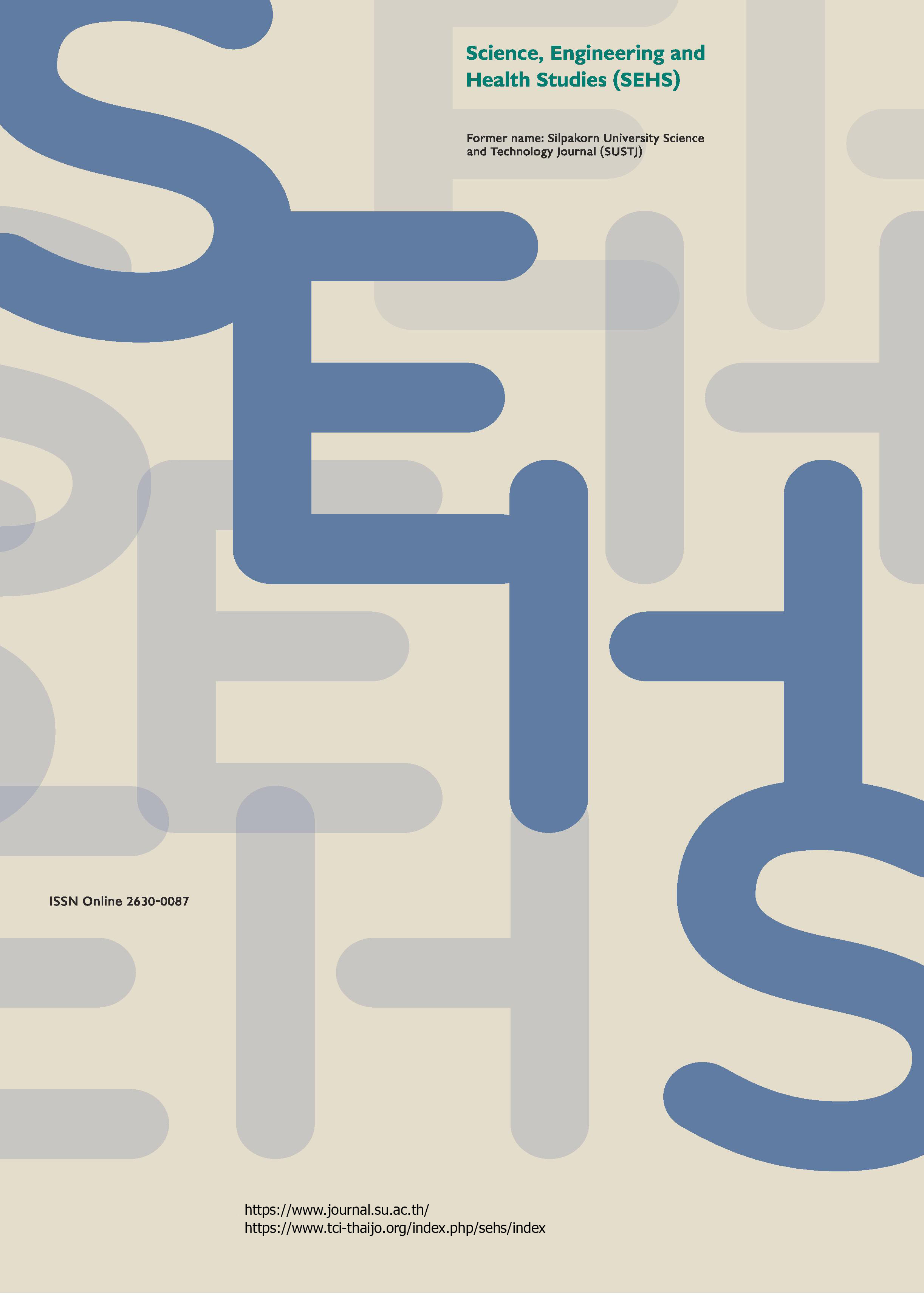Development of isolated panduratin A-loaded solid lipid nanoparticles as a transdermal delivery system for cosmeceutical products
Main Article Content
Abstract
Panduratin A (PA), isolated from Boesenbergia rotunda (L.) Mansf., is a cyclohexenyl chalcone derivative with low water solubility, from which a suitable transdermal delivery system could be developed to improve skin penetration. Solid lipid nanoparticles (SLNs) are carriers for lipophilic drugs to penetrate the skin layers. Therefore, the objective of this study was to develop SLN containing PA as a transdermal delivery system. Cytotoxicity studies in skin cells, (normal human fibroblasts (NHFs) and human immortalized keratinocytes (HaCaTs),) were evaluated. The PA-loaded SLN formulations were formulated and characterized. From the results revealed that PA was not toxic to NHF and HaCaT cells at 1 µg/mL concentrations, indicating no cytotoxicity of skin cells. SLN formulation 0.1%w/v of PA-loaded SLN (SLN4) exhibited favorable properties such as the nanometer size, negative zeta potential, and the highest entrapment efficiency at 99.81%. The release and skin permeation study showed that PA from SLN4 was released from and permeated through skin better than oil (control) at all sampling times. In conclusion, PA has no skin cell cytotoxicity and is suitable to be used as a cosmeceutical ingredient. SLN4 plays a ideal role as a transdermal delivery system of PA, resulting from its suitable physicochemical properties and ability to permeate the skin.
Downloads
Article Details

This work is licensed under a Creative Commons Attribution-NonCommercial-NoDerivatives 4.0 International License.
References
Arora, R., Katiyar, S. S., Kushwah, V., and Jain, S. (2017). Solid lipid nanoparticles and nanostructured lipid carrier-based nanotherapeutics in treatment of psoriasis: A comparative study. Expert Opinion on Drug Delivery, 14(2), 165–177.
Atun, S., and Handayani, S. (2017). Synthesis of nanoparticles produced by ethanol extract of Boesenbergia rotunda rhizome loaded with chitosan and alginic acid and its biological activity test. Pharmacognosy Journal, 9(2), 142–147.
Baroli, B. (2010). Penetration of nanoparticles and nanomaterials in the skin: fiction or reality? Journal of Pharmaceutical Sciences, 99(1), 2–50.
Boonyarattanasoonthorn, T., Kongratanapasert, T., Jiso, A., Techapichetvanich, P., Nuengchamnong, N., Supannapan, K., Kijtawornrat, A., and Khemawoot, P. (2023). Absolute oral bioavailability and possible metabolic pathway of panduratin A from Boesenbergia rotunda extract in beagle dogs. Pharmaceutical Biology, 61(1), 590–597.
Eng-Chong, T., Yean-Kee, L., Chin-Fei, C., Choon-Han, H., Sher-Ming, W., Li-Ping, C. T., Gen-Teck, F., Khalid, N., Abd Rahman, N., Karsani, S. A., Othman, S., Othman, R., and Yusof, R. (2012). Boesenbergia rotunda: from ethnomedicine to drug discovery. Evidence-Based Complementary and Alternative Medicine, 2012, 473637.
Gupta, S., Kesarla, R., Chotai, N., Misra, A., and Omri, A. (2017). Systematic approach for the formulation and optimization of solid lipid nanoparticles of efavirenz by high pressure homogenization using design of experiments for brain targeting and enhanced bioavailability. BioMed Research International, 2017, 5984014.
Mandawgade, S. D., and Patravale, V. B. (2008). Development of SLNs from natural lipids: Application to topical delivery of tretinoin. International Journal of Pharmaceutics, 363(1–2), 132–138.
Mattos, C. B., Argenta, D. F., Melchiades, G. L., Cordeiro, M. N. S., Tonini, M. L., Moraes, M. H., Weber, T. B., Roman, S. S., Nunes, R. J., Teixeira, H. F., Steindel, M., and Koester, L. S. (2015). Nanoemulsions containing a synthetic chalcone as an alternative for treating cutaneous leshmaniasis: Optimization using a full factorial design. International Journal of Nanomedicine, 10, 5529–5542.
Mehnert, W., and Mader, K. (2001). Solid lipid nanoparticles production, characterization and applications. Advanced Drug Delivery Reviews, 47(2–3), 165–196.
Mei, Z., Chen, H., Weng, T., Yang, Y., and Yang, X. (2003). Solid lipid nanoparticle and microemulsion for topical delivery of triptolide. European Journal of Pharmaceutics and Biopharmaceutics, 56(2), 189–196.
Menon, G. K., Lee, S. H., and Robert, M. S. (1998). Ultrastructural effects of some solvents and vehicles on the stratum corneum and other skin components: Evidence for an “extended mosaic partitioning model of the skin barrier”. In Dermal Absorption and Toxicity Assessment (Roberts, M. S., and Walters, K. A., Eds.), pp. 727–751. Marcel Dekker, New York: CRC Press.
PubChem. (2023). PubChem compound summary for CID 6483648. National Center for Biotechnology Information, [Online URL: https://pubchem.ncbi.nlm.nih.gov/compound/Panduratin-A] accessed on May 22, 2023.
Rangsimawong, W., Opanasopit, P., Rojanarata, T., Duangjit, S., and Ngawhirunpat, T. (2016). Skin transport of hydrophilic compound-loaded PEGylated lipid nanocarriers: Comparative study of liposomes, niosomes, and solid lipid nanoparticles. Biological and Pharmaceutical Bulletin, 39(8), 1254–1262.
Rao, H., Ahmad, S., Madni, A., Rao, I., Ghazwani, M., Hani, U., Umair, M., Ahmad, I., Rai, N., Ahmed, M., and Khan, K. U. R. (2022). Compritol-based alprazolam solid lipid nanoparticles for sustained release of alprazolam: Preparation by hot melt encapsulation. Molecules. 27(24), 8894.
Schubert, M. A., and Müller-Goymann, C. C. (2005). Characterisation of surface-modified solid lipid nanoparticles (SLN): Influence of lecithin and nonionic emulsifier. European Journal of Pharmaceutics and Biopharmaceutics, 61(1–2), 77–86.
Shim, J. S., Kwon, Y. Y., and Hwang, J. K. (2008). The effects of panduratin A isolated from Kaempferia pandurata on the expression of matrix metalloproteinase-1 and type-1 procollagen in human skin fibroblasts. Planta Medica, 74(3), 239–244.
Silva, A. M., Martins-Gomes, C., Coutinho, T. E., Fangueiro, J. F., Sanchez-Lopez, E., Pashirova, T. N., Andreani, T., and Souto, E. B. (2019). Soft cationic nanoparticles for drug delivery: Production and cytotoxicity of solid lipid nanoparticles (SLNs). Applied Sciences, 9(20), 4438.
Uner, M., and Yener, G. (2007). Importance of solid lipid nanoparticles (SLNs) in various administration routes and future perspectives. International Journal of Nanomedicine, 2(3), 289–300.
Woo, S. W., Rhim, D. B., Kim, C., and Hwang, J. K. (2015). Effect of standardized Boesenbergia pandurata extract and its active compound panduratin A on skin hydration and barrier function in human epidermal keratinocytes. Preventive Nutrition and Food Science, 20(1), 15–21.
Yu, Y. Q., Yang, X., Wu, X. F., and Fan, Y. B. (2021). Enhancing permeation of drug molecules across the skin via delivery in nanocarriers: Novel strategies for effective transdermal applications. Frontiers in Bioengineering and Biotechnology, 9, 646554.


